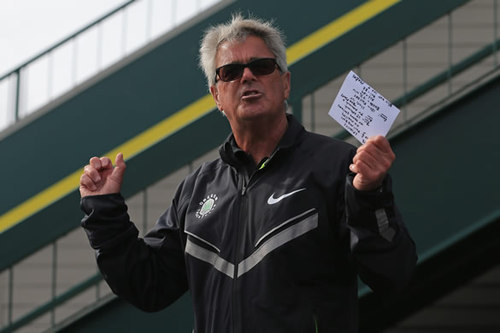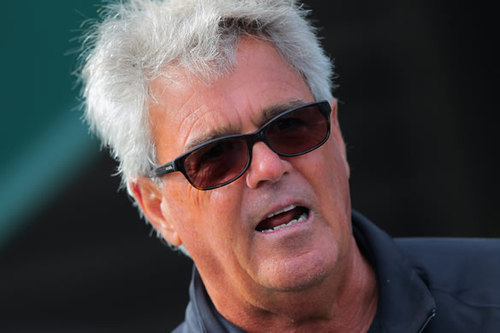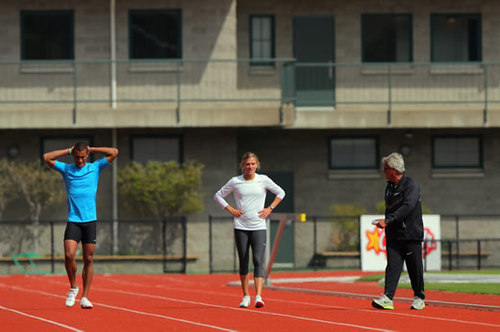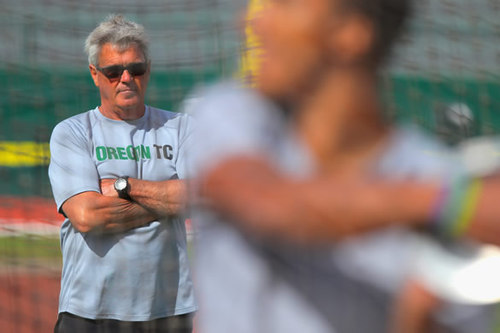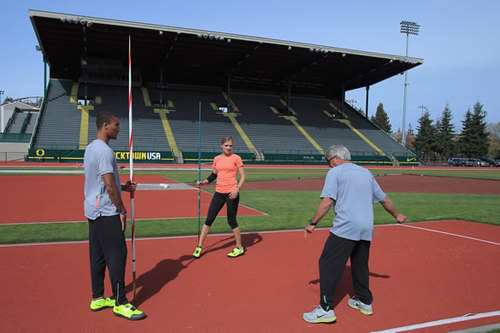Harry Marra, photo by Doug Pensinger/Getty Images for the IAAF,
A Day in the Life, April 2013
Updated January 6, 2017
Larry Eder opines: I finished a quick interview this morning with Harry Marra. Before I post that, I wanted to repost this interview from 2015 by David Hunter. David did a wonderful job describing one of the most important coaches in our sport. Harry Marra is a man of much generosity. He is also a keen observer, and analyst of athletic talent. He is also, finally, one of the kindest people I know. He loved the last seven years coaching Ashton and Brianne.
I love coaches. I love to watch them coach, I love to watch them with their athletes and with other coaches. They have a sacred trust: passing down centuries of athletic history and tradition, while using modern training techniques to help their athletes achieve a goal. Coaches build character.
Harry Marra is one of the finest coaches that I know. Coaches are confessors, cheerleaders, salesman, and shrinks, all rolled up into one. A great coach, and Harry Marra is that, toil their entire lives, enjoying those infrequent moments when things all jell.
Harry Marra is having the time of his life. In the 1990s, Harry and Fred Samara developed the VISA Decathlon program, saving one of the most iconic events in American sports history from disintegrating.
In the 2012, Harry Marra coached Ashton Eaton to his best performances, and a World record at the US Olympic Trials. When Harry Marra tells me just how good Brianne Theisen-Eaton is, I believe him.
Dave Hunter captured my friend as only Mr. Hunter could: with the respect that this fine coach deserves.
Harry Marra: 10 Event Maestro
Exceptional Deca Coach Is Multi-Talented
May 17th, 2015
More so than in most sports, competent coaching is a critical ingredient for the success of any track & field performer. And unlike most sports, the skillful coaches that guide the athletic fortunes of our sport’s greatest athletes toil in virtual anonymity. Frequently ununiformed, seldom interviewed, and rarely in the spotlight, these mentors work on meet day in the shadows of the sport. After months – even years – of preparation and seeking that one final edge, they might offer their athlete a final tip, a gentle reminder, or a last word intended to send their gladiator off to battle in the best mental state possible. You often have to work to spot these corner men – and women – who play such a pivotal role in the success of their athletes. But you can find them if you try. And if you do, you might be able to observe veteran multiple event coach Harry Marra – perhaps the best in the business.
Harry Marra, photo by Doug Pensinger/Getty Images for the IAAF,
A Day in the Life, April 2013
Marra, a veteran coach in his late 60’s, cites an active upbringing as contributing to his skill as a multi-event mentor. “The skill I have as a coach which led to the success I have experienced guiding athletes really was initially developed in Cohoes, New York as a little kid,” offers Marra with enthusiasm. “In the 50’s, we did everything. You played every single sport imaginable. And you played it year round. And you shoveled the streets so we could play basketball in the winter. Hockey and everything else. You name the sport, we did it. And I think the innate ability that I developed in learning how to do those sports on the playground really helped.”
A competitive decathlete himself several decades ago, Marra now sees how that experience aids his multi coaching and endows him with a certain street cred. “I think you can do it [multi event coaching] without being a decathlete. But I think it [a coach’s own decathlete experience] makes the road that much straighter.” Marra – who guides Olympic gold medalist and world record holder Ashton Eaton and his Olympic silver medalist spouse Brianne Theisen Eaton – has firsthand insight into the challenges of multi-event coaching. “There are a lot of nuances about the decathlon/heptathlon that you have to cross. The decisions I make at the level I coach are really as tough any decision a young coach faces starting out. There is no cookie-cutter program for multi-event training – absolutely none. Every decision you make – to go; to not go; to push this workout; to back off this workout; to add more strength training; whatever it may be – all comes down to knowledge and experience that you have gained over the years.” Marra adds, “And I’ve been at it a lot of years.”
Ashton Eaton, Brianne Theison-Eaton, with Coach Marra, photo by Doug Pensinger/Getty Images for the IAAF,
A Day in the Life, April 2013
His years of experience have allowed him to craft his own multi-event coaching philosophy. “We have a saying that Ash and Bri and I use: ‘I coach to the athlete.'” Marra – who eschews the one-size-fits-all thinking – prefers a more tailored approach to multi coaching. “I design a program that fits whatever abilities Ash and Bri have and then we go forward with it. Instead of a cookie-cutter program – this is what you are supposed to do in the fall and this is what you are supposed to do in the winter – I look specifically what their attributes are and then I play to those attributes.”
When Marra joined the University of Oregon track and field staff as a multi coach in the fall of 2009, both Eaton and Theisen were well into their college careers. The veteran coach jumped right in, but also took time to assess the talent and other attributes these already-accomplished athletes demonstrated. “When you look at an athlete relative to the multi-events, you have to look beyond just athletic ability,” Marra explains. “A lot of guys have athletic ability. But do they have the mental state to carry on over two days in a stressful situation and deal with the chaos surrounding multi-events? You can’t script the multi-event as to how it will unfold. It is just going to change time, after time, after time again.” Marra liked what he saw. “I saw those essential other qualities in Ashton. He’s a very smart kid, a very practical kid, a very analytical kid – as is Brianne in all these cases. And they’re obviously very good athletically, too.”
Harry Marra observing Ashton Eaton,
photo by Doug Pensinger/Getty Images for the IAAF, A Day in the Life, April 2013
Marra couldn’t wait to get to work. “Over the course of three months’ time, I started to add in some dimensions athletically for Ash that were more of the elite level,” the coach explains. “He adapted to them immediately – and I mean immediately, beyond immediately. And then I saw specifically – hands-on – his ability as an athlete. So when you combine those two aspects – his athletic ability and his attention to detail – you have something very special.”
Marra – who currently serves as the Multi-Event Coach for the Oregon Track Club Elite – notes that both Ashton and Brianne leave nothing to chance. “Ashton and Brianne are both students of the game. They go home at night and do their homework,” Marra reveals. “You don’t become a great multi-event guy simply by working out 2 or 3 hours a day on the track and that’s it. You have to go home and do your study. You have to look at video. You have to think about your event. You have to review what practice will be the next day. You have to eat properly. You have to sleep properly. You have to get enough rest and what have you.” Marra adds, “And they do that.”
Ashton Eaton, Brianne Theisen-Eaton, Harry Marra, photo by Doug Pensinger/Getty Images for the IAAF, A Day in the Life, April 2013
Coach Marra doesn’t get hung up on a singular Athenian body type being essential for multi-event success. “They have done studies on that. And studies are studies – and that’s all they are,” the coach notes dismissively. “There is no real practical implication to that. In the 60’s and 70’s, maybe 6’1″ and 195 pounds was supposedly the right size. But in today’s world, you are looking for the more springy, wiry athletic-type athlete,” Marra reveals. “You don’t need to be enormous like the 60’s and 70’s guys thought they had to be in order to throw the shot, discus, and javelin. Does it take strength to do those events? Of course. But in the decathlon and heptathlon, it takes more skill than it does strength. 90 percent of the kids that do the multi events don’t do the techniques correctly because they don’t have as much time to prepare each of the techniques because you’re doing so many other events. Ashton is billed as 6 feet and 175 pounds. He is lighter now that he ever was. It is not a brute force event; it is an athletic event – 10 different skills that have all athletic techniques. And you have to be a well-rounded athlete.”
Global medals aside, many consider Eaton’s 2012 U.S. Olympic Trials world record decathlon to be his – and Marra’s – zenith performance to date. How did the coach and athlete react in the midst of the crowd buzz that wafted through Hayward Field after his young protégé set decathlon world records in the first two Day One events? “Do you want to hear an honest answer? Or do you want to hear the party line?” asks Marra playfully. “The honest answer is the same stuff was going through my mind as it would in any decathlon: ‘Yeah, they were good performances [100m in 10.21 and LJ in 8.23m / 27’0″] But who cares? Whatever. It was two events. We did them the way we were supposed to do them. The performances happened to be very good. And we moved on.’ I didn’t pay attention to them. I didn’t get excited about them. And don’t think he got overly excited about them. I didn’t say anything to him after the 100 meters. I gave him a high five after the long jump. And I immediately said, ‘Hey, don’t forget. The shot put. Stay closed and watch your left arm.'”
Marra is all about keeping a performing athlete’s emotions on an even keel. ‘If you get all fired up about some event that you did real well, or if you get all depressed about some event that you just stunk the house out, that’s not the path to take to become a multi-event athlete,” he explains. “There is time after the meet when you can sit back and say, ‘Wow, that was pretty good.’ But not during the competition.”
Eaton’s 2012 OT roll continued. Not even Mother Nature could derail Marra’s athlete. Running the 400m – the Day One final event – in 46.70 against a hard rain, Eaton concluded the day with 4728 points. The Hayward crowd – which included every living American Olympic gold medalist in the decathlon – knew that Sebrle’s world record mark of 9026 was in danger. “We planned that,” explains Marra with pride as he references the presence of the prior champions. “That didn’t just magically happen. Every city that hosts an Olympic Trials has to do something to honor track and field in some way. 2012 was the 100th anniversary of the decathlon when Jim Thorpe won in Stockholm. So I went to Lananna and said, ‘This is the thing you should do – honor the decathlon.’ And they brought in all the guys – they’re all good friends of mine. It was magical.”
The excitement built during Day Two. And when – after 9 events – the rain finally stopped, the clouds parted, and the sun shone on the glistening infield grass, it was like, well, a Hollywood movie. And when Curtis Beach and Ty Detmer swung wide and slowed on the final straightaway of the 1500 meters to allow Eaton to break the world record and win the final event, the crowd – earlier advised of the necessary time Eaton would have to run to break Sebrle’s mark – erupted. Adds Marra: “My wife Madeline who has been through the decathlon wars with me for the past 46 years plus, immediately said, ‘If Hollywood doesn’t make a movie out of that scenario, they’re missing the boat completely.'”
As a former decathlete, Marra knows how exhausting training for and competing in the 10-event competition can be. And he was savvy enough to find a way to provide a rest year for his multi thoroughbred. “Sometime in the spring of 2013, I said to Ashton, ‘We’re not doing this nonsense next year. There is no way in hell you’re doing the decathlon. You’re shot to hell. You’re tired. I’m exhausted. I don’t even want to see a decathlon next year.’ So we left it at that. Later that summer, before Moscow, we were doing a workout on the track at Hayward. I was standing at the first turn near where the first intermediate hurdle would normally be. Ashton, now in his flats, shouted to me from the start line and said, ‘Hey coach, watch this.” He crouched down, simulated a start, ran 21 steps to where the first hurdle would normally be and then mimicked a perfect hurdle clearance. He then took 13 steps in between and mimicked a clearance of each imaginary hurdle through 200 meters. I said, ‘That’s it. Next year: 400 meter hurdles. No question.'” Freed from the bondage of 10 event training, Eaton worked with Marra to turn 2014 into a fun, reinvigorating year of new challenge. The result? A PR, season best of 48.69 and a #6 world ranking in an event in which he had never before competed.
Looking ahead, Marra does not see difficulty in keeping both Ashton and Brianne inspired and focused. “It is really not a hard thing to do – at least in Ashton’s case and in Brianne’s case. They are two driven individuals,” states Marra. “They’re goal might be to win medals and win championships. But their real goal is to keep improving in each event. I know that’s what their goal is. Then it is my job then to make sure I am on top of my coaching end and to bring them along – not just to be in shape for Beijing this summer, but to be at their best ever for Beijing. So my job is to play to what their desires are – improving in each event – so that their total score can lead to a new PR. I think both of them would say that they will walk away from the event when they feel they have done everything they can in the event, and that’s it, that’s the best we’re going to do. But they haven’t found that yet. It’s still wide open.” And as a final note, Marra adds, “”I can say this: both are committed to winning in Rio in 2016.”
When asked about how he would like to be remembered, Marra – seldom at a loss for words – pauses. “I never thought of that,” he admits. But then he offers, “A good coach. A hard-working coach. An honest coach who played by the rules and created an environment within coaching that was both growth-producing and offered fun along the way.” And he quickly adds, “Fun is always a huge part of my deal in life.”
Harry Marra, photo by Doug Pensinger/Getty Images for the IAAF,
A Day in the Life, April 2013
Harry Marra – who will soon release his new book, My Life In The Decathlon – has specific goals left to achieve. “One of my goals with the challenge of daily practice is to be very well prepared for practice,” notes Marra in reference to his daily work with two of the world’s greatest athletes. “I want to be so prepared that something positive comes out of each practice so they are on the road to keep moving forward and keep improving day to day right up to Rio – and beyond if we keep going.” And with smile, he adds, “Another of my goals is to make sure that when I am done coaching Ash and Bri – whenever that may be – that I can live for at least 10 more years so I can sit back at home in California in my garden with a nice big glass of red wine and say, ‘Yeah, we kicked ass.'”

Dave Hunter, who ran his marathon P.R. of 2:31:40 on the highly revered Boston Marathon course back in the Paleozoic era, is a track and field announcer, broadcaster, and journalist. To find out more about Dave, please visit www.trackandfieldhunter.com.

